Backwards: When Politicians Choose Their Voters
Voters are suppose to choose elected officials, not the other way around.
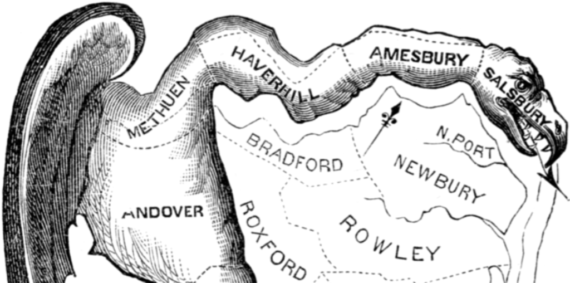
A core tenet of representative democracy is the governed choose the government. That is, citizens, exercising their rights to participate in free and fair elections, collectively elect office-holders. However, in the United States, due to the usage of single-seat districts as the fence put around those voters, office-holders can, through the redistricting process, choose their own voters.
This violates the very notion of elected, representative democracy.
This situation in the United States is made possible because of our strict two-party system wherein, aided by computers, politicians can manipulate district lines to create districts that very clearly contain advantageous populations of voters who are highly likely to vote for a specific party, regardless of candidate and very likely regardless of policy debates. (Yes, some voters change their minds and some districts can change due to demographic and migratory changes over time, but on balance, such changes are rare relative to the overall population).
Let’s consider Illinois. In 2020 the state voted 57.5% for Biden and 40.6% for Trump which matched the average results of presidential contests in Illinois since 2000 (57% for Ds, 41% for Rs, and 2% for others). Hence, It is not unfair to characterize the state as roughly 57-41 D to R (which tracks within a couple of points with the 2018 governor’s race and Senator Duckworth’s 2016 election).
Its current House delegation is 13 D, 5 R (so, 72.2% D and 27.8% R). This already tells us that the state’s lines are drawn in a way that favors Democrats (or, at a minimum, that the outcomes of Illinois House races do not reflect the actual partisan breakdown of the state’s population as inferred from the presidential vote). Indeed, that is a pretty significant deviation that should be concerning if one is interested in quality of representation.
Starting in 2022 the state will lose 1 seat, down to 17. So what might the breakdown look like?
The not yet approved map would create 14 Democratic seats and three Republicans. That’s 82.4% of the seats for the Ds and 17.6% for the Rs on what will likely be a ~57-41 D/R vote split statewide in November of 2022.
A partisan Democratic response might well be: “Good! Turnabout is fair play.” After all, other states, like Texas, will be gerrymandering their districts to favor Rs. And, perhaps from a tactical point of view, one could make the argument that given our rules, this is how the game has to be played.
But, I have to stress that the game in question isn’t democracy, and that should concern anyone who actually thinks democratic governance is desirable.
Meanwhile, speaking of Texas, Mother Jones assesses that Texas Republicans Are Pulling Out All the Stops to Dilute the Voting Power of People of Color.
Through the redistricting process, Texas Republicans are building a sea wall against demographic change—an early indicator of how the Republican Party nationally is responding to momentous population changes not by reaching out to growing communities of color but by diluting their voting power. At a time when Texas is becoming more diverse and Democratic, the new maps drawn by Republicans for congress and the state legislature would make the state’s political representation far whiter and more Republican, all but ending competition at the very moment when ascendant Democrats are finally making the state competitive.
Of course, since racial demographics correlate strongly with partisan voting, the Republicans have every interest in diminishing the voting power of non-whites.
White voters have been a minority in Texas since 2004 and over the past decade 95 percent of the state’s growth came from communities of color, but the GOP’s proposed congressional map increases the number of white Republican districts and decreases the number of majority-Latino and majority-Black districts. It packs minority voters into as few urban areas as possible in cities like Austin, Dallas, and Houston to limit their representation, while spreading out the rest among deeply red exurban and rural areas to nullify their influence. Despite gaining nearly 2 million Hispanic residents and more than 500,000 Black residents since 2010, Republicans didn’t draw a single new majority-Latino or majority-Black congressional district. Instead, the two new House seats the state gained due to population growth were given to majority-white areas in Austin and Houston.
Like I said above: politicians picking their voters. I know this is not new, but increasing partisanship and improved technology mean it is deeper and more common. And regardless of anything else, it is unhealthy (at least if one values democracy).
And I would note: if we had proportional representation, the issue of majority-minority districts is moot. A group’s voting strength is their actual proportional size in the population.
All of this is made worse in the US due to our too-small House of Representatives and the fact that most districts are drawn by partisans in legislators. (While a movement to nonpartisan redistricting process would be an improvement, they would not solve the underlying problems). Keep in mind that at least part of the issue is residency patterns (i.e., partisans tend to cluster, especially in cities).
All of these problems and issues are the direct result of our system. Multi-seat districts in proportional representation systems can’t be gerrymandered. For that matter, multi-party systems make gerrymandering almost pointless even in single-seat plurality systems like in the UK.
Back to the new Texas map
Republican House candidates won 53 percent of the statewide vote in 2020 but would hold a projected 65 percent of seats under the new lines, which were approved by the state Senate redistricting committee on Monday. The number of safe GOP seats would double, from 11 to 22, while the number of competitive districts would fall from 12 to just one.
Our system is simply not representative.
Some examples of the maps in Texas:

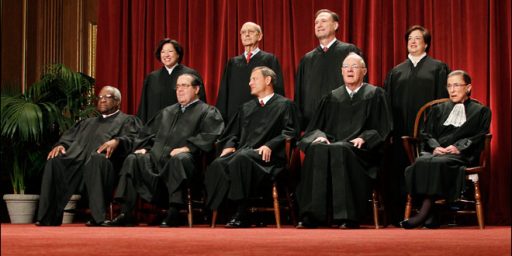
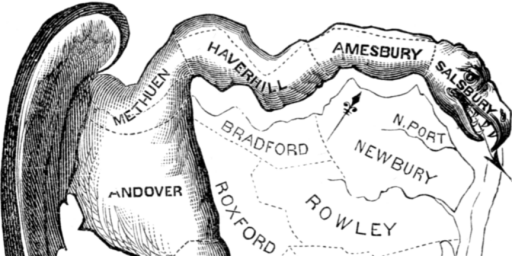
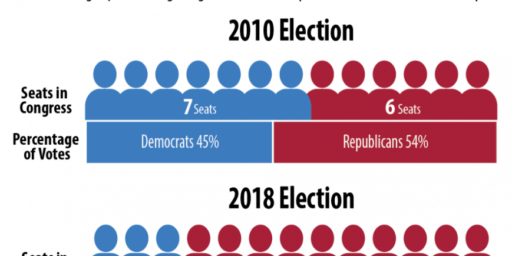
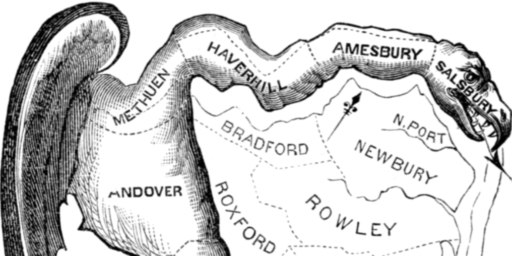

Well, according to Chief Justice Roberts, that’s all just “sociological gobbledygook.”
@Kurtz: Indeed.
Sigh.
@Kurtz: @Steven L. Taylor: But remember, not a single member of Teh Supremes comes to his workday intending to decide anything based on ideological presuppositions. Alito (IIRC) just said so a few weeks go. (I didn’t buy it, but that’s another story altogether.)
We can all rest easy. Democracy is safe in the hands of The Supremes. Pinky swear!
It is fundamentally insane that we allow partisan, elected officials to run their own elections, but let’s be clear: even with independent election commissions and redistricting commissions, it is impossible to draw fair boundaries as long as you submit to the wholly arbitrary restriction of electing only one representative in each district. For fair and accurate representation, you need a proportional voting system. More info here: http://fairvote.org
@Wayne Smith:
And it still wouldn’t be enough. Even with proportional representation, the system greatly favors people who start out as successful small business owners. As I am fond of saying, “You know which group is the most unrepresented in Congress? Hourly wage slaves.”
@Michael Cain:
WAITACOTTONPICKINGMINUTE!
You mean we have to let actually have a say? Nope, not gonna let that happen!
@Just nutha ignint cracker:
As long as it’s a pinky swear, I’m relieved. No, really, I swear.
I am absolutely not convinced that proportional voting is a good thing. All my life I’ve watched the need for major parties to get just a few more votes turn Israel from a beacon of light to an apartheid state.
@MarkedMan:
The issue with Israeli proportional voting, is that there is no minimum percentage of the vote that a party needs to receive to earn seats. Therefore you end up with these extreme parties that control one or two seats. Plus there is a general refusal by the mainstream parties to include the Arab parties in a government.
The Texas Tribune has a tool that lets you enter your street address and see how redistricting will affect you. For every single elected office that has a redrawn map, my district has gotten at least 5% whiter and more Trumpian.
Since I moved here, Bryan and College Station have combined to make up TX-14 in the TX House without any tomfoolery. This time around, they’ve carved out a bunch of the black and Hispanic parts of Bryan in order to move them into the mostly white, mostly rural district that mostly engulfs TX-14, where they will get no effective representation. TX-14 was getting too close to flippable from R to D, and the new versions will now both has at least a 60/40 R/D split.
This is a non-sequitur.
The population of Texas is just under 30M. Adding 2.5M POC is an 8% increase.
Adding a “majority [POC]” district would either a) require that the increase in POC population has primarily happened in geographically proximate areas or b) districts are gerrymandered to make them majority POC.
Even with districts drawn via mathematically pure means, an increase of 8% in PsOC wouldn’t ensure that any district is majority POC–especially since Texas is 70% white*.
I want fair maps. I want agnostic maps. I want maps that are based on:
The one problem I have with a lot of “fair maps” advocates on the left is that they don’t see it as “fair” maps–they see it as “how can we get our side more power–while pretending to be fair?”
As I said yesterday, anyone who says “we need to ensure that X have a representative” is biased.
Within a few years, the US will be “minority white” (those identifying as “white” will be less than 50% of the population). A truly fair map doesn’t need to “make sure X minority is represented”–because it will happen by default.
And, of course, this doesn’t even touch on the (arguably racist) notion held by the left that every non-white racial/ethnic group is monolithic in their political leanings (the “black vote”, the “Hispanic vote”, etc.)
=================
* From Wikipedia on the 2010 census. I’m too lazy to look up the 2020 numbers.
Eh, I think of it as a nice try, but we could get rid of those 3 Republican seats. Imagine a map where every district gets a bit of Chicago…each district can be 57-41, and represent a perfectly balanced cross section of the state.
The zero Republican district map would make a fine test case to force the Supreme Court to take up partisan gerrymandering.
Is it better to pretend to play democracy, or to blow the lie wide open?
My preference would be a fair balance — multiseat districts, proportional representation, non-partisan commissions… something along those lines.
Pass a crazy partisan no-Republican map (ok, 2-3 Republicans…), along with legislation to switch to a nonpartisan commission drawing maps when all other states with more than one electoral district do the same.
@Mu Yixiao: I honestly think you’ve fallen into one of those “this common sense solution should be perfect” traps when it generates horrific outcomes in practice.
Which is also basically libertarianism.
The emphasis on geographic compactness looks nice, but it creates the same imbalances that we have in the electoral college.
I favor every state having districts created with a roughly minimum-wasted-votes strategy — that’s going to get a close to a proportional representation as we can get with single party districts.
Illinois’ delegation should be roughly 57% Dem and 43% Rep.
@Mu Yixiao: Also, while I don’t like the idea of arranging districts to ensure a black or Latino can get elected there, the reality is that unless those communities get a seat at the table when decisions are getting made, they will be an afterthought and not get represented.
It would be like the Republicans in the theoretical zero Republican map for Illinois. Sure, there’s a representative that ostensibly represents them, but would they really get represented?
Think about the gay rights movement. It only hit a critical mass when people in positions of power started coming either coming out or being replaced by out queerfolk. It didn’t take a lot, it just required a seat at the table.
A state’s Representatives should look like the state — gender, race, urban/rural and political bent. That should be the goal. And we should bend and shove things to get there with our imperfect system.
——
ETA: This is also why I find your “secret queer subculture thing” at odds with “not supporting vanilla lesbians getting baked goods that are generally available to the public.” They’re rights are literally your rights, and if you want to be freaky in private, go for it, but eventually there’s a slip and someone sees behind the curtain, and then some landlords start saying “I don’t want to rent to no Star Trek bondage furries… I don’t know what a targ is, but I know I don’t want it on my property.”
——
ETA2: “what do you mean Targs have six genders? And Tribbles are hermaphrodites? Not on my property! God created Adam and Eve, not Adam, Eve and Knife and Willow and… Noah would have let those things drown!”
@Mu Yixiao: Non-Hispanic Whites have been a minority in Texas for over a decade, and currently are right around 40% of the state’s population. It’s right in the Wikipedia article you claim to be citing:
https://en.wikipedia.org/wiki/Texas#Race_and_ethnicity
Mother Jones magazine? I thought they went out in the 60’s. It is amusing that you show a map of ultra-Dem controlled Massachusetts, segue to a brief about ultra-Dem controlled Illinois but save your dismay for Republican Texas. Your ignorance not withstanding, you should see the data published by Texas Monthly, (not known as a “conservative” magazine by any rational person) and you’d see that your pipe-dream of monolithic Democrat Latinos actually is a pipe dream. Latinos, Hispanics, or Tejanos, (pick your choice) and Anglos, live with the daily invasion of illegals and Democrat strongholds along the border are turning purple, away from solid blue. Issues such as abortion, prosperity, opportunity, and education still count to the basically conservative Hispanic population. You’d have to live in a vacuum if you don’t see that Biden’s “open border” policy is a human rights and political disaster in the making.
@John430:
I would suggest you are allowing your own partisan blinders to affect your reading of the post. The whole thing about the overall system and I used two examples (Illinois and Texas).
The fact that you are interpreting a map from early 19th century Mass. as somehow a comment on contemporary politics gives credence to my assertion that you are allowing partisanship to influence your reading of the piece.
You want to show me where I said that?
And what does that have to do with the price of tea in China? (i.e., what does that have to do with districting?).